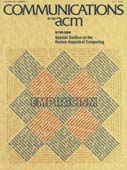The human aspects of computing: a note on this collection
What makes computer users happy? Can systems help humans to use them? Does programming sharpen other thinking skills? Is computer anxiety important? Will programmers use Ada packages? How do students learn programming concepts? Are spelling correctors at their limits? When does the work load on a terminal get too heavy? Are instruction sets too large?
These nine questions define some important issues for those of us who study human factors—the ways hardware and software affect, and are affected by, their users. Although the major accomplishments in the field will always rest on careful inspiration, to some degree these questions can be resolved empirically.
Generally, empirical work falls into three broad categories:
With experiments the goal is to determine whether some design or principle A is better than some design or principle B. Ideally, experimenters should make some tentative hypothesis first, or at least, decide what needs to be known.
In data collection the objective is to observe users, give questionnaires, examine listings, count errors, or otherwise record data. By examining such data, we are able to draw conclusions and discover trouble spots.
General observation is a method that involves complete systems or prototypes. These systems are observed, measured in broad ways, compared, or iteratively redesigned to complement the behavior of typical users. The goal is to understand the needs of users and to optimize system behavior.
Although not at all by choice, only the first two of these categories are represented in this collection.
As with most papers that are accepted and appear in print, the reviewers or editors have some special reason for liking a paper in the first place. This reason may not appear in the reviews of the paper, but it does capture some underlying point or principle deemed to be important.
Each of the articles in this special section is a short description of a study addressing one of the nine questions. The results of these studies do not always reinforce conventional wisdom. Some of the conclusions are provocative. I invite you to read the articles and to see whether you agree with their conclusions.




